Leadership and Management: Classical Theories and Service Industries
VerifiedAdded on 2021/03/15
|17
|4282
|649
Report
AI Summary
This report delves into the realm of leadership and management within the service industry, meticulously reviewing classical management theories and diverse leadership styles. It begins by assessing these theories and applying them to a service industry context, explaining the role of leaders and the various leadership styles prevalent in this sector. A specific service sector organization, DX Freight, is used as a case study to analyze management and leadership styles in relation to organizational structure and culture. The report then investigates internal and external factors influencing management styles and structures, identifying strengths and weaknesses. Furthermore, it assesses current and future management and leadership skills, evaluating their crucial role in the service sector and how these skills evolve in response to change. The report concludes by comparing change management systems and leadership approaches in different service industry organizations, analyzing how change management impacts management and leadership skills and styles.
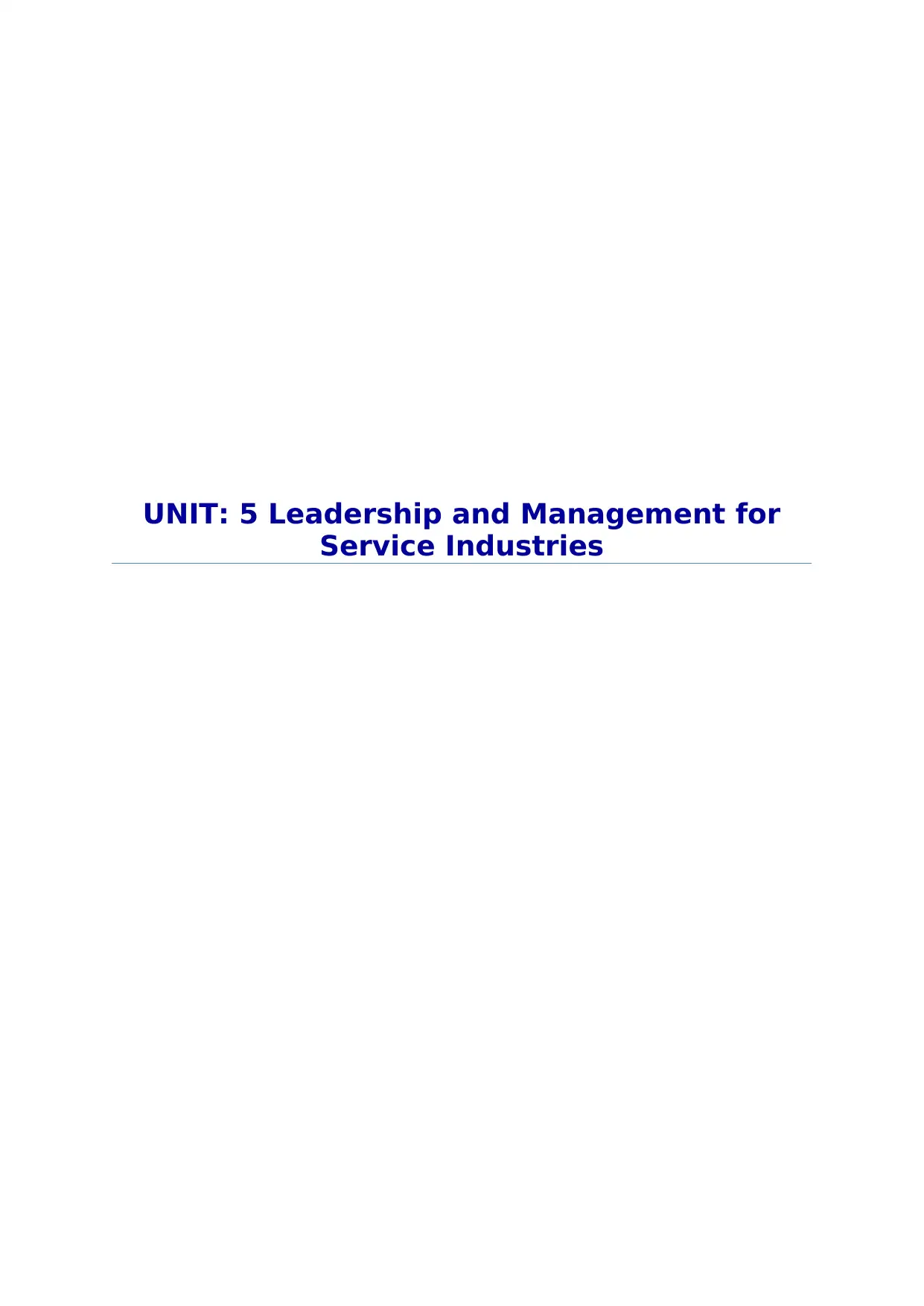
UNIT: 5 Leadership and Management for
Service Industries
Service Industries
Paraphrase This Document
Need a fresh take? Get an instant paraphrase of this document with our AI Paraphraser
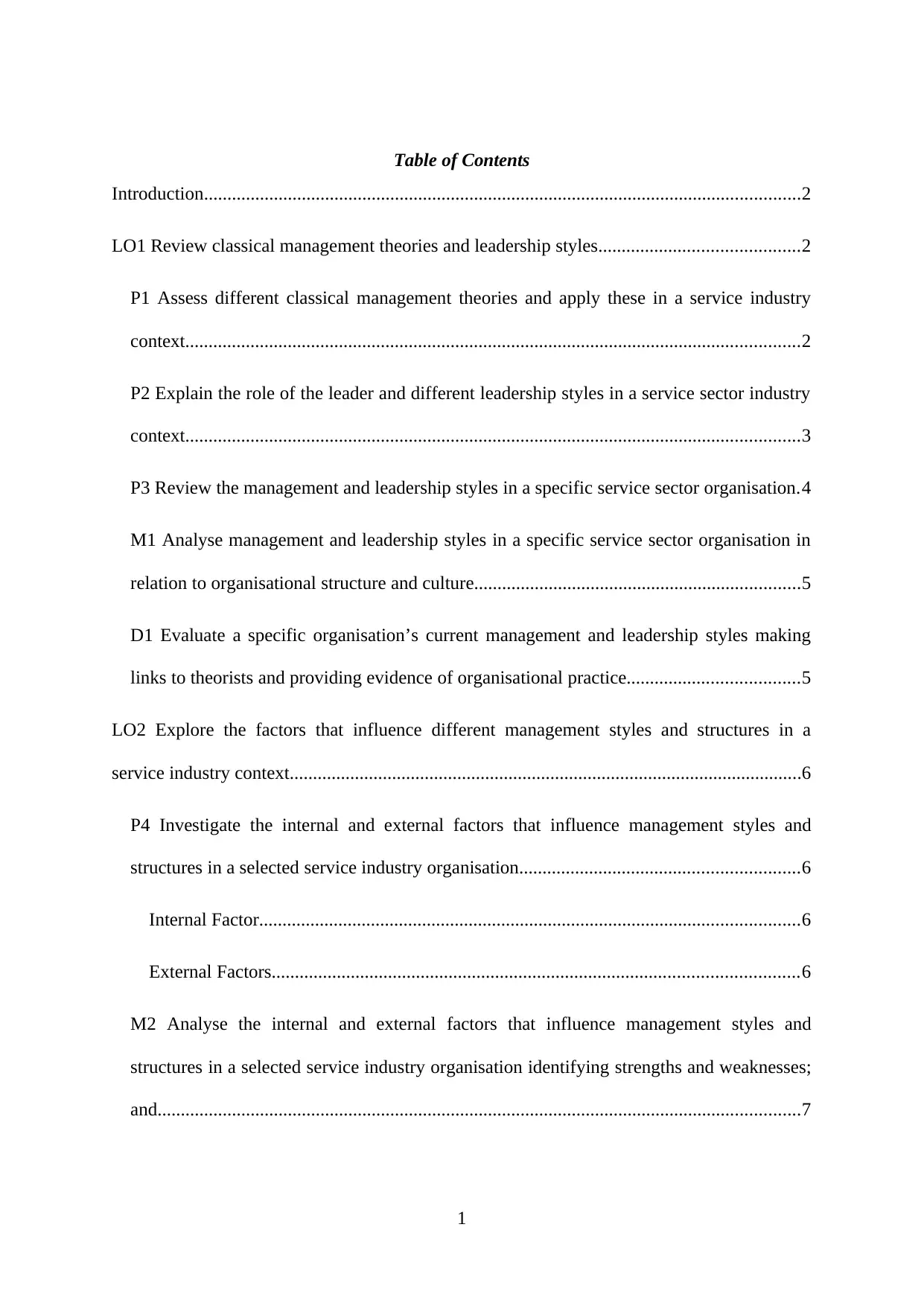
Table of Contents
Introduction................................................................................................................................2
LO1 Review classical management theories and leadership styles...........................................2
P1 Assess different classical management theories and apply these in a service industry
context....................................................................................................................................2
P2 Explain the role of the leader and different leadership styles in a service sector industry
context....................................................................................................................................3
P3 Review the management and leadership styles in a specific service sector organisation.4
M1 Analyse management and leadership styles in a specific service sector organisation in
relation to organisational structure and culture......................................................................5
D1 Evaluate a specific organisation’s current management and leadership styles making
links to theorists and providing evidence of organisational practice.....................................5
LO2 Explore the factors that influence different management styles and structures in a
service industry context..............................................................................................................6
P4 Investigate the internal and external factors that influence management styles and
structures in a selected service industry organisation............................................................6
Internal Factor....................................................................................................................6
External Factors.................................................................................................................6
M2 Analyse the internal and external factors that influence management styles and
structures in a selected service industry organisation identifying strengths and weaknesses;
and..........................................................................................................................................7
1
Introduction................................................................................................................................2
LO1 Review classical management theories and leadership styles...........................................2
P1 Assess different classical management theories and apply these in a service industry
context....................................................................................................................................2
P2 Explain the role of the leader and different leadership styles in a service sector industry
context....................................................................................................................................3
P3 Review the management and leadership styles in a specific service sector organisation.4
M1 Analyse management and leadership styles in a specific service sector organisation in
relation to organisational structure and culture......................................................................5
D1 Evaluate a specific organisation’s current management and leadership styles making
links to theorists and providing evidence of organisational practice.....................................5
LO2 Explore the factors that influence different management styles and structures in a
service industry context..............................................................................................................6
P4 Investigate the internal and external factors that influence management styles and
structures in a selected service industry organisation............................................................6
Internal Factor....................................................................................................................6
External Factors.................................................................................................................6
M2 Analyse the internal and external factors that influence management styles and
structures in a selected service industry organisation identifying strengths and weaknesses;
and..........................................................................................................................................7
1
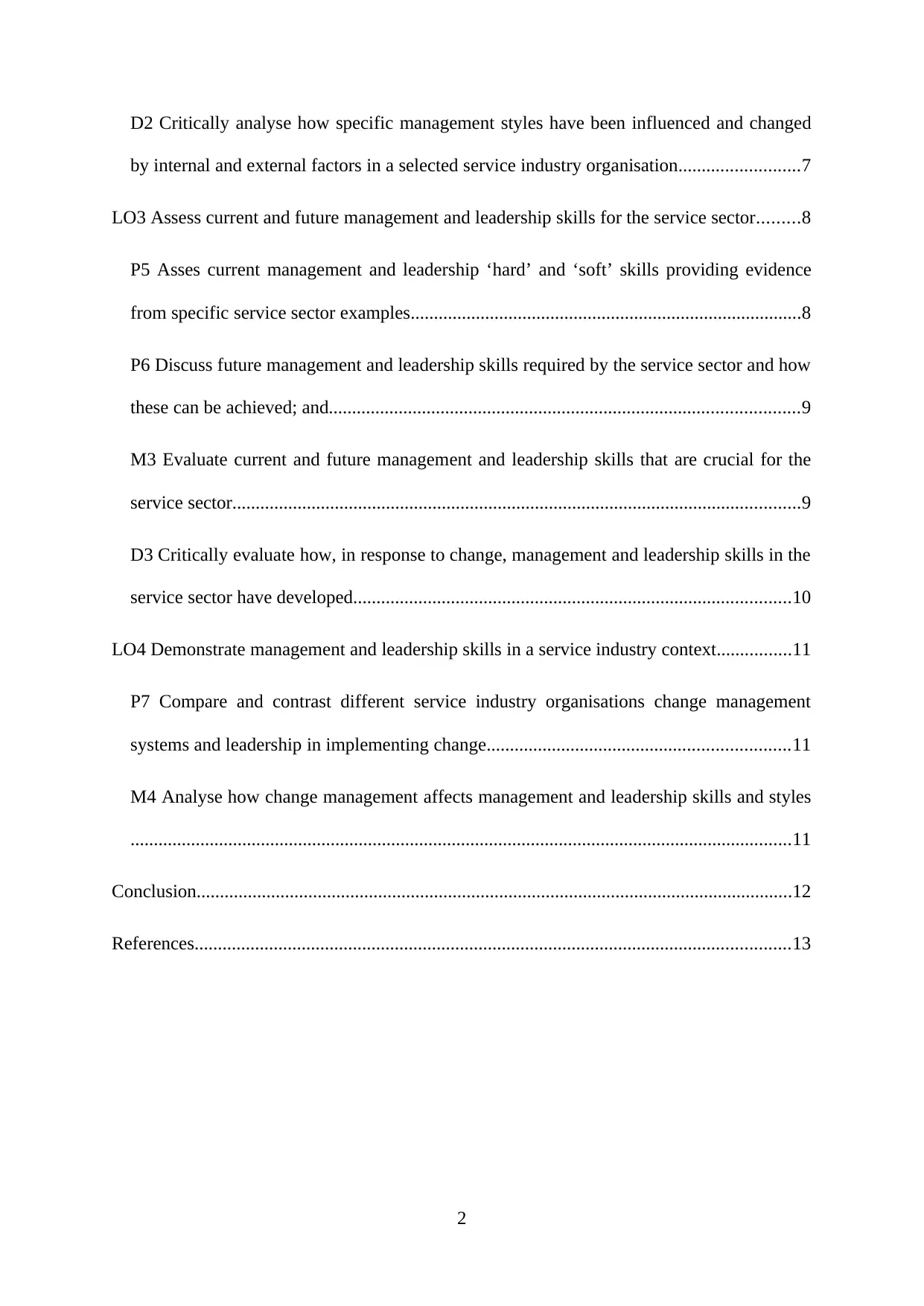
D2 Critically analyse how specific management styles have been influenced and changed
by internal and external factors in a selected service industry organisation..........................7
LO3 Assess current and future management and leadership skills for the service sector.........8
P5 Asses current management and leadership ‘hard’ and ‘soft’ skills providing evidence
from specific service sector examples....................................................................................8
P6 Discuss future management and leadership skills required by the service sector and how
these can be achieved; and.....................................................................................................9
M3 Evaluate current and future management and leadership skills that are crucial for the
service sector..........................................................................................................................9
D3 Critically evaluate how, in response to change, management and leadership skills in the
service sector have developed..............................................................................................10
LO4 Demonstrate management and leadership skills in a service industry context................11
P7 Compare and contrast different service industry organisations change management
systems and leadership in implementing change.................................................................11
M4 Analyse how change management affects management and leadership skills and styles
..............................................................................................................................................11
Conclusion................................................................................................................................12
References................................................................................................................................13
2
by internal and external factors in a selected service industry organisation..........................7
LO3 Assess current and future management and leadership skills for the service sector.........8
P5 Asses current management and leadership ‘hard’ and ‘soft’ skills providing evidence
from specific service sector examples....................................................................................8
P6 Discuss future management and leadership skills required by the service sector and how
these can be achieved; and.....................................................................................................9
M3 Evaluate current and future management and leadership skills that are crucial for the
service sector..........................................................................................................................9
D3 Critically evaluate how, in response to change, management and leadership skills in the
service sector have developed..............................................................................................10
LO4 Demonstrate management and leadership skills in a service industry context................11
P7 Compare and contrast different service industry organisations change management
systems and leadership in implementing change.................................................................11
M4 Analyse how change management affects management and leadership skills and styles
..............................................................................................................................................11
Conclusion................................................................................................................................12
References................................................................................................................................13
2
⊘ This is a preview!⊘
Do you want full access?
Subscribe today to unlock all pages.

Trusted by 1+ million students worldwide
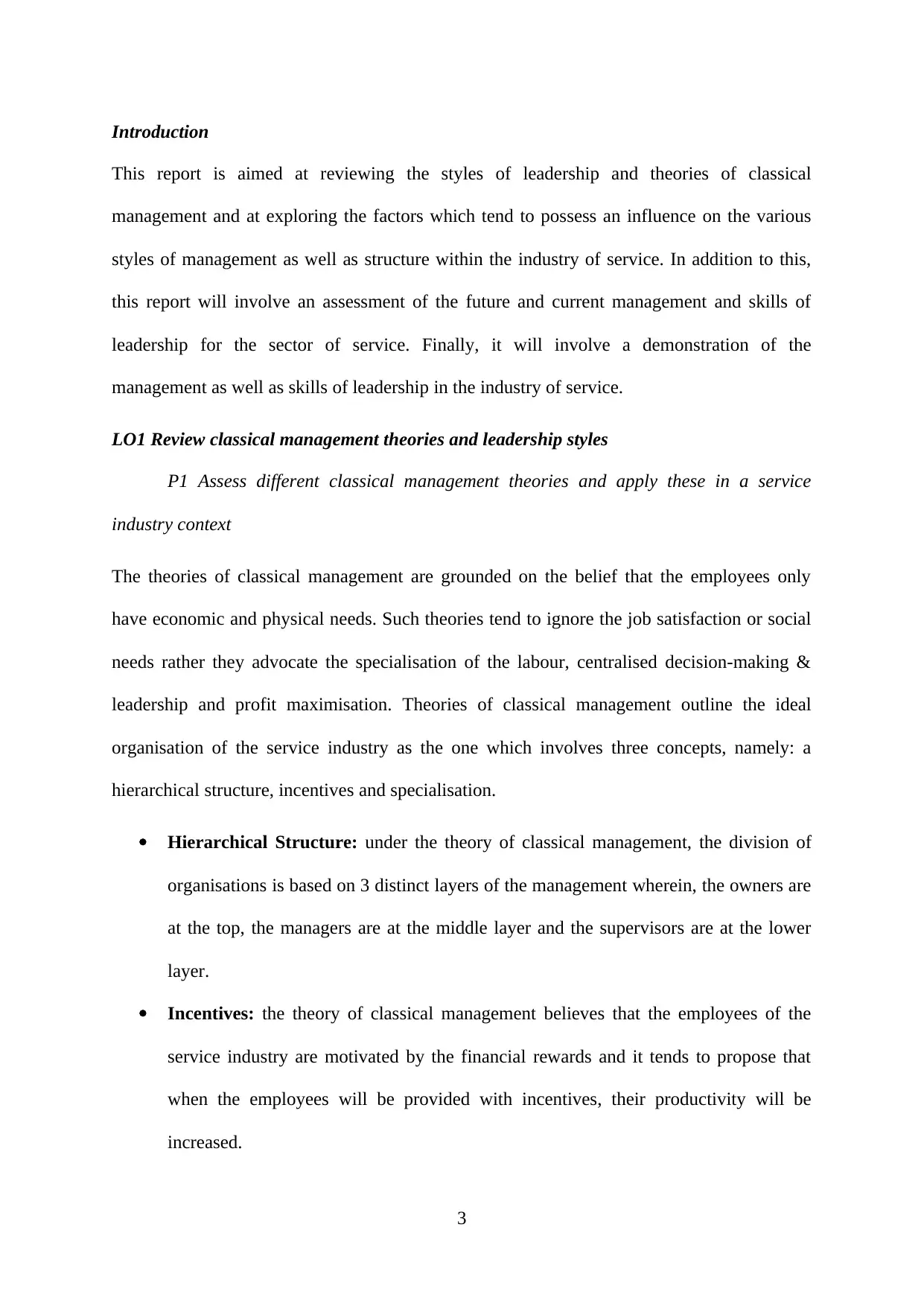
Introduction
This report is aimed at reviewing the styles of leadership and theories of classical
management and at exploring the factors which tend to possess an influence on the various
styles of management as well as structure within the industry of service. In addition to this,
this report will involve an assessment of the future and current management and skills of
leadership for the sector of service. Finally, it will involve a demonstration of the
management as well as skills of leadership in the industry of service.
LO1 Review classical management theories and leadership styles
P1 Assess different classical management theories and apply these in a service
industry context
The theories of classical management are grounded on the belief that the employees only
have economic and physical needs. Such theories tend to ignore the job satisfaction or social
needs rather they advocate the specialisation of the labour, centralised decision-making &
leadership and profit maximisation. Theories of classical management outline the ideal
organisation of the service industry as the one which involves three concepts, namely: a
hierarchical structure, incentives and specialisation.
Hierarchical Structure: under the theory of classical management, the division of
organisations is based on 3 distinct layers of the management wherein, the owners are
at the top, the managers are at the middle layer and the supervisors are at the lower
layer.
Incentives: the theory of classical management believes that the employees of the
service industry are motivated by the financial rewards and it tends to propose that
when the employees will be provided with incentives, their productivity will be
increased.
3
This report is aimed at reviewing the styles of leadership and theories of classical
management and at exploring the factors which tend to possess an influence on the various
styles of management as well as structure within the industry of service. In addition to this,
this report will involve an assessment of the future and current management and skills of
leadership for the sector of service. Finally, it will involve a demonstration of the
management as well as skills of leadership in the industry of service.
LO1 Review classical management theories and leadership styles
P1 Assess different classical management theories and apply these in a service
industry context
The theories of classical management are grounded on the belief that the employees only
have economic and physical needs. Such theories tend to ignore the job satisfaction or social
needs rather they advocate the specialisation of the labour, centralised decision-making &
leadership and profit maximisation. Theories of classical management outline the ideal
organisation of the service industry as the one which involves three concepts, namely: a
hierarchical structure, incentives and specialisation.
Hierarchical Structure: under the theory of classical management, the division of
organisations is based on 3 distinct layers of the management wherein, the owners are
at the top, the managers are at the middle layer and the supervisors are at the lower
layer.
Incentives: the theory of classical management believes that the employees of the
service industry are motivated by the financial rewards and it tends to propose that
when the employees will be provided with incentives, their productivity will be
increased.
3
Paraphrase This Document
Need a fresh take? Get an instant paraphrase of this document with our AI Paraphraser
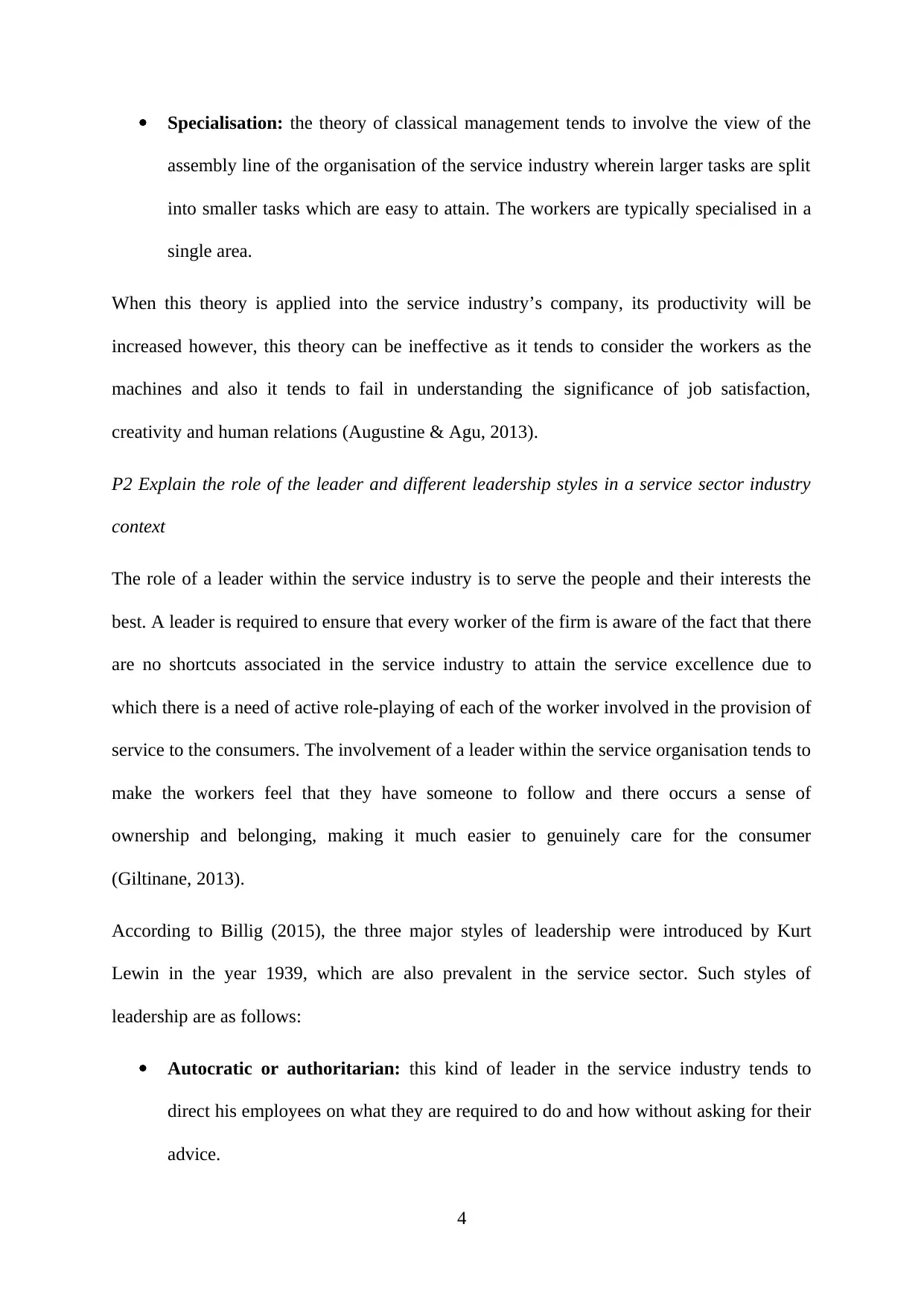
Specialisation: the theory of classical management tends to involve the view of the
assembly line of the organisation of the service industry wherein larger tasks are split
into smaller tasks which are easy to attain. The workers are typically specialised in a
single area.
When this theory is applied into the service industry’s company, its productivity will be
increased however, this theory can be ineffective as it tends to consider the workers as the
machines and also it tends to fail in understanding the significance of job satisfaction,
creativity and human relations (Augustine & Agu, 2013).
P2 Explain the role of the leader and different leadership styles in a service sector industry
context
The role of a leader within the service industry is to serve the people and their interests the
best. A leader is required to ensure that every worker of the firm is aware of the fact that there
are no shortcuts associated in the service industry to attain the service excellence due to
which there is a need of active role-playing of each of the worker involved in the provision of
service to the consumers. The involvement of a leader within the service organisation tends to
make the workers feel that they have someone to follow and there occurs a sense of
ownership and belonging, making it much easier to genuinely care for the consumer
(Giltinane, 2013).
According to Billig (2015), the three major styles of leadership were introduced by Kurt
Lewin in the year 1939, which are also prevalent in the service sector. Such styles of
leadership are as follows:
Autocratic or authoritarian: this kind of leader in the service industry tends to
direct his employees on what they are required to do and how without asking for their
advice.
4
assembly line of the organisation of the service industry wherein larger tasks are split
into smaller tasks which are easy to attain. The workers are typically specialised in a
single area.
When this theory is applied into the service industry’s company, its productivity will be
increased however, this theory can be ineffective as it tends to consider the workers as the
machines and also it tends to fail in understanding the significance of job satisfaction,
creativity and human relations (Augustine & Agu, 2013).
P2 Explain the role of the leader and different leadership styles in a service sector industry
context
The role of a leader within the service industry is to serve the people and their interests the
best. A leader is required to ensure that every worker of the firm is aware of the fact that there
are no shortcuts associated in the service industry to attain the service excellence due to
which there is a need of active role-playing of each of the worker involved in the provision of
service to the consumers. The involvement of a leader within the service organisation tends to
make the workers feel that they have someone to follow and there occurs a sense of
ownership and belonging, making it much easier to genuinely care for the consumer
(Giltinane, 2013).
According to Billig (2015), the three major styles of leadership were introduced by Kurt
Lewin in the year 1939, which are also prevalent in the service sector. Such styles of
leadership are as follows:
Autocratic or authoritarian: this kind of leader in the service industry tends to
direct his employees on what they are required to do and how without asking for their
advice.
4
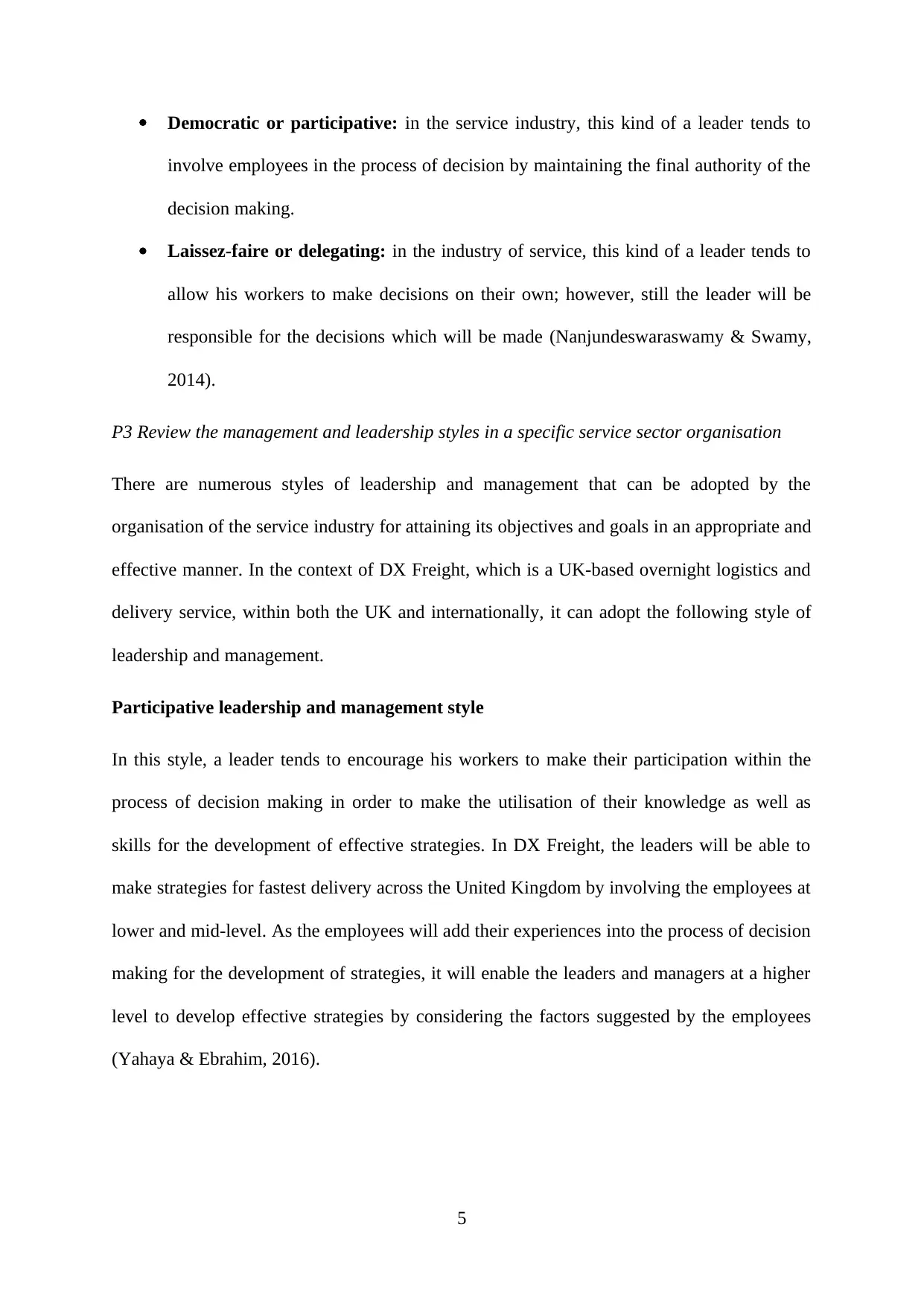
Democratic or participative: in the service industry, this kind of a leader tends to
involve employees in the process of decision by maintaining the final authority of the
decision making.
Laissez-faire or delegating: in the industry of service, this kind of a leader tends to
allow his workers to make decisions on their own; however, still the leader will be
responsible for the decisions which will be made (Nanjundeswaraswamy & Swamy,
2014).
P3 Review the management and leadership styles in a specific service sector organisation
There are numerous styles of leadership and management that can be adopted by the
organisation of the service industry for attaining its objectives and goals in an appropriate and
effective manner. In the context of DX Freight, which is a UK-based overnight logistics and
delivery service, within both the UK and internationally, it can adopt the following style of
leadership and management.
Participative leadership and management style
In this style, a leader tends to encourage his workers to make their participation within the
process of decision making in order to make the utilisation of their knowledge as well as
skills for the development of effective strategies. In DX Freight, the leaders will be able to
make strategies for fastest delivery across the United Kingdom by involving the employees at
lower and mid-level. As the employees will add their experiences into the process of decision
making for the development of strategies, it will enable the leaders and managers at a higher
level to develop effective strategies by considering the factors suggested by the employees
(Yahaya & Ebrahim, 2016).
5
involve employees in the process of decision by maintaining the final authority of the
decision making.
Laissez-faire or delegating: in the industry of service, this kind of a leader tends to
allow his workers to make decisions on their own; however, still the leader will be
responsible for the decisions which will be made (Nanjundeswaraswamy & Swamy,
2014).
P3 Review the management and leadership styles in a specific service sector organisation
There are numerous styles of leadership and management that can be adopted by the
organisation of the service industry for attaining its objectives and goals in an appropriate and
effective manner. In the context of DX Freight, which is a UK-based overnight logistics and
delivery service, within both the UK and internationally, it can adopt the following style of
leadership and management.
Participative leadership and management style
In this style, a leader tends to encourage his workers to make their participation within the
process of decision making in order to make the utilisation of their knowledge as well as
skills for the development of effective strategies. In DX Freight, the leaders will be able to
make strategies for fastest delivery across the United Kingdom by involving the employees at
lower and mid-level. As the employees will add their experiences into the process of decision
making for the development of strategies, it will enable the leaders and managers at a higher
level to develop effective strategies by considering the factors suggested by the employees
(Yahaya & Ebrahim, 2016).
5
⊘ This is a preview!⊘
Do you want full access?
Subscribe today to unlock all pages.

Trusted by 1+ million students worldwide
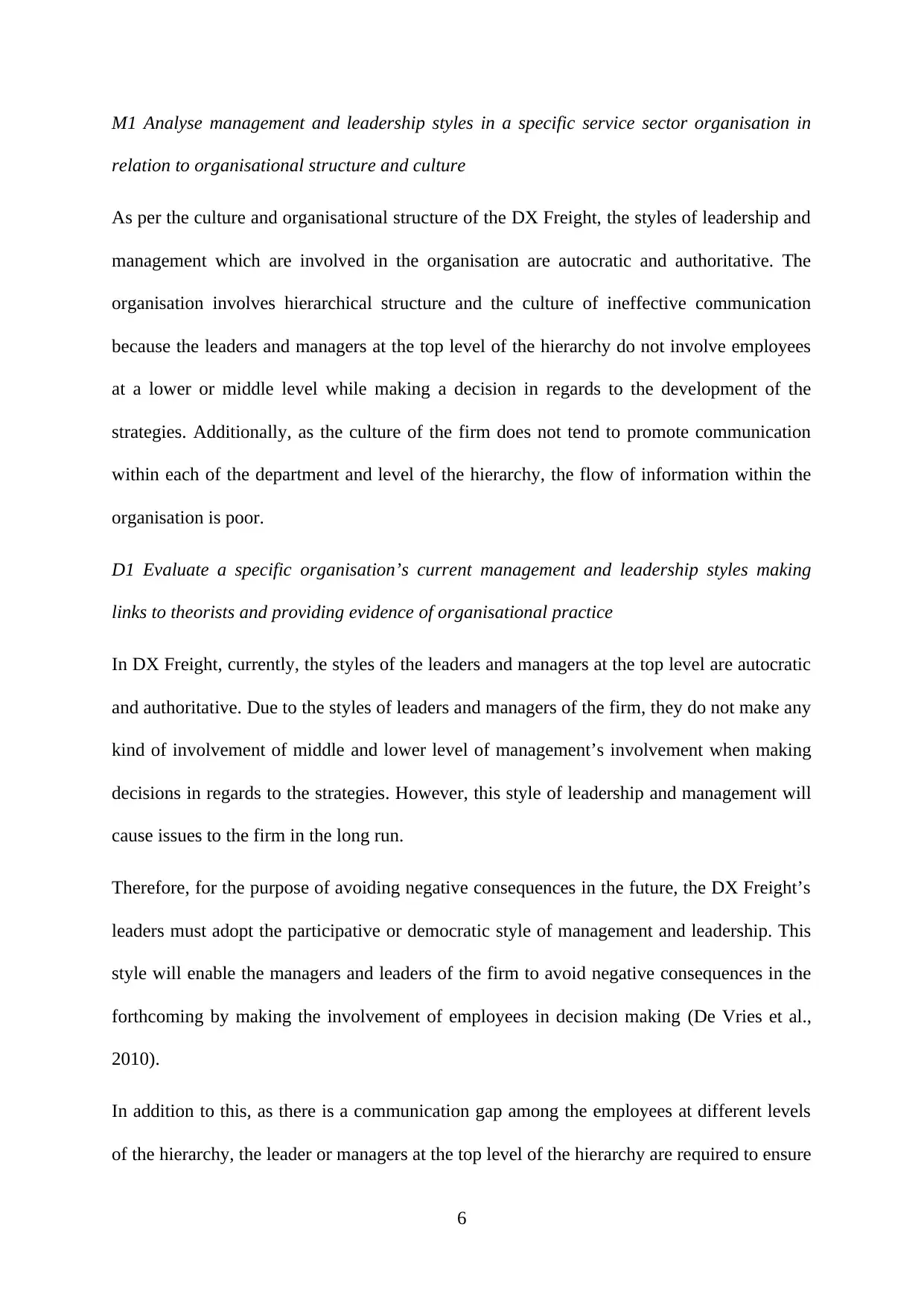
M1 Analyse management and leadership styles in a specific service sector organisation in
relation to organisational structure and culture
As per the culture and organisational structure of the DX Freight, the styles of leadership and
management which are involved in the organisation are autocratic and authoritative. The
organisation involves hierarchical structure and the culture of ineffective communication
because the leaders and managers at the top level of the hierarchy do not involve employees
at a lower or middle level while making a decision in regards to the development of the
strategies. Additionally, as the culture of the firm does not tend to promote communication
within each of the department and level of the hierarchy, the flow of information within the
organisation is poor.
D1 Evaluate a specific organisation’s current management and leadership styles making
links to theorists and providing evidence of organisational practice
In DX Freight, currently, the styles of the leaders and managers at the top level are autocratic
and authoritative. Due to the styles of leaders and managers of the firm, they do not make any
kind of involvement of middle and lower level of management’s involvement when making
decisions in regards to the strategies. However, this style of leadership and management will
cause issues to the firm in the long run.
Therefore, for the purpose of avoiding negative consequences in the future, the DX Freight’s
leaders must adopt the participative or democratic style of management and leadership. This
style will enable the managers and leaders of the firm to avoid negative consequences in the
forthcoming by making the involvement of employees in decision making (De Vries et al.,
2010).
In addition to this, as there is a communication gap among the employees at different levels
of the hierarchy, the leader or managers at the top level of the hierarchy are required to ensure
6
relation to organisational structure and culture
As per the culture and organisational structure of the DX Freight, the styles of leadership and
management which are involved in the organisation are autocratic and authoritative. The
organisation involves hierarchical structure and the culture of ineffective communication
because the leaders and managers at the top level of the hierarchy do not involve employees
at a lower or middle level while making a decision in regards to the development of the
strategies. Additionally, as the culture of the firm does not tend to promote communication
within each of the department and level of the hierarchy, the flow of information within the
organisation is poor.
D1 Evaluate a specific organisation’s current management and leadership styles making
links to theorists and providing evidence of organisational practice
In DX Freight, currently, the styles of the leaders and managers at the top level are autocratic
and authoritative. Due to the styles of leaders and managers of the firm, they do not make any
kind of involvement of middle and lower level of management’s involvement when making
decisions in regards to the strategies. However, this style of leadership and management will
cause issues to the firm in the long run.
Therefore, for the purpose of avoiding negative consequences in the future, the DX Freight’s
leaders must adopt the participative or democratic style of management and leadership. This
style will enable the managers and leaders of the firm to avoid negative consequences in the
forthcoming by making the involvement of employees in decision making (De Vries et al.,
2010).
In addition to this, as there is a communication gap among the employees at different levels
of the hierarchy, the leader or managers at the top level of the hierarchy are required to ensure
6
Paraphrase This Document
Need a fresh take? Get an instant paraphrase of this document with our AI Paraphraser
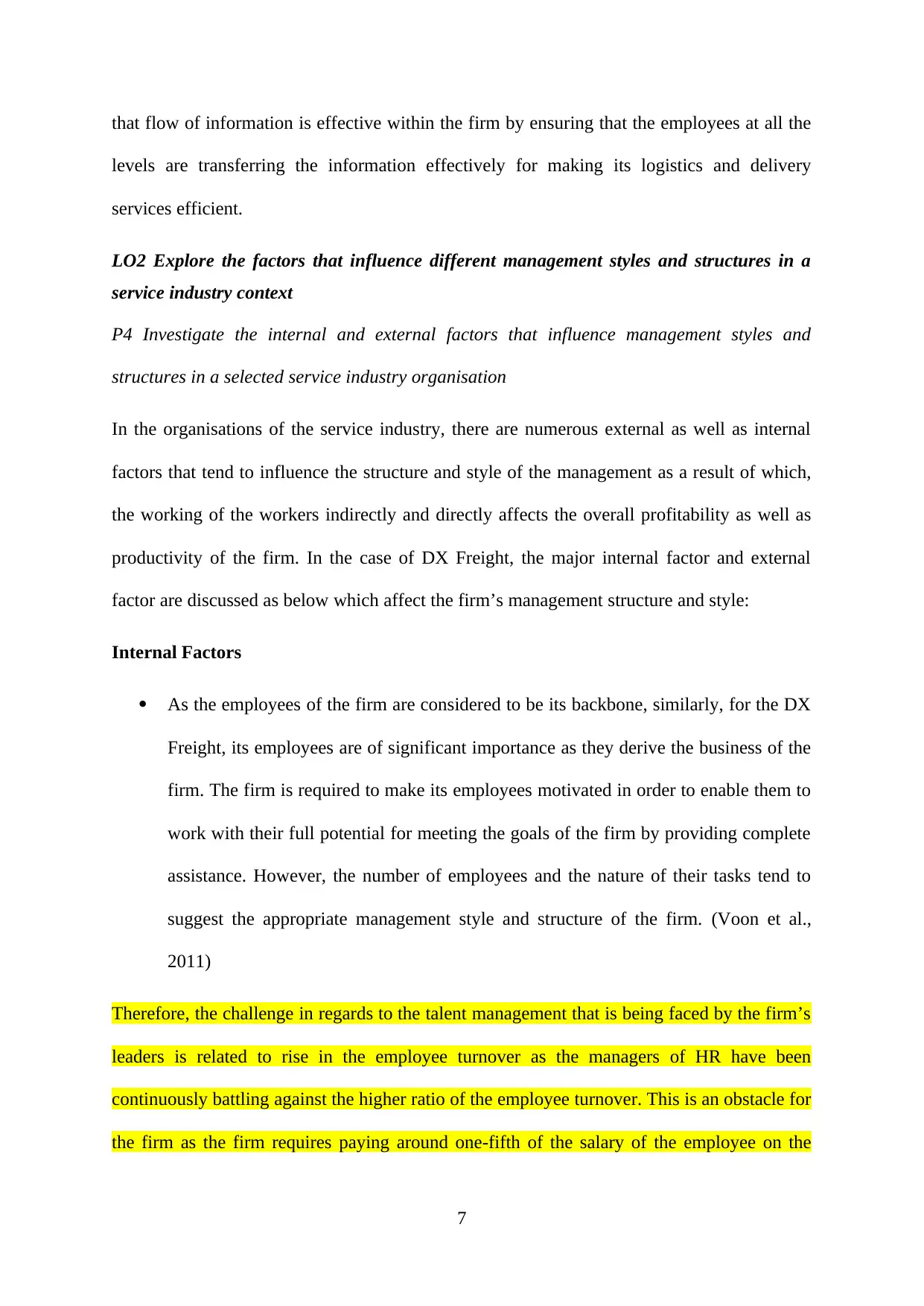
that flow of information is effective within the firm by ensuring that the employees at all the
levels are transferring the information effectively for making its logistics and delivery
services efficient.
LO2 Explore the factors that influence different management styles and structures in a
service industry context
P4 Investigate the internal and external factors that influence management styles and
structures in a selected service industry organisation
In the organisations of the service industry, there are numerous external as well as internal
factors that tend to influence the structure and style of the management as a result of which,
the working of the workers indirectly and directly affects the overall profitability as well as
productivity of the firm. In the case of DX Freight, the major internal factor and external
factor are discussed as below which affect the firm’s management structure and style:
Internal Factors
As the employees of the firm are considered to be its backbone, similarly, for the DX
Freight, its employees are of significant importance as they derive the business of the
firm. The firm is required to make its employees motivated in order to enable them to
work with their full potential for meeting the goals of the firm by providing complete
assistance. However, the number of employees and the nature of their tasks tend to
suggest the appropriate management style and structure of the firm. (Voon et al.,
2011)
Therefore, the challenge in regards to the talent management that is being faced by the firm’s
leaders is related to rise in the employee turnover as the managers of HR have been
continuously battling against the higher ratio of the employee turnover. This is an obstacle for
the firm as the firm requires paying around one-fifth of the salary of the employee on the
7
levels are transferring the information effectively for making its logistics and delivery
services efficient.
LO2 Explore the factors that influence different management styles and structures in a
service industry context
P4 Investigate the internal and external factors that influence management styles and
structures in a selected service industry organisation
In the organisations of the service industry, there are numerous external as well as internal
factors that tend to influence the structure and style of the management as a result of which,
the working of the workers indirectly and directly affects the overall profitability as well as
productivity of the firm. In the case of DX Freight, the major internal factor and external
factor are discussed as below which affect the firm’s management structure and style:
Internal Factors
As the employees of the firm are considered to be its backbone, similarly, for the DX
Freight, its employees are of significant importance as they derive the business of the
firm. The firm is required to make its employees motivated in order to enable them to
work with their full potential for meeting the goals of the firm by providing complete
assistance. However, the number of employees and the nature of their tasks tend to
suggest the appropriate management style and structure of the firm. (Voon et al.,
2011)
Therefore, the challenge in regards to the talent management that is being faced by the firm’s
leaders is related to rise in the employee turnover as the managers of HR have been
continuously battling against the higher ratio of the employee turnover. This is an obstacle for
the firm as the firm requires paying around one-fifth of the salary of the employee on the
7
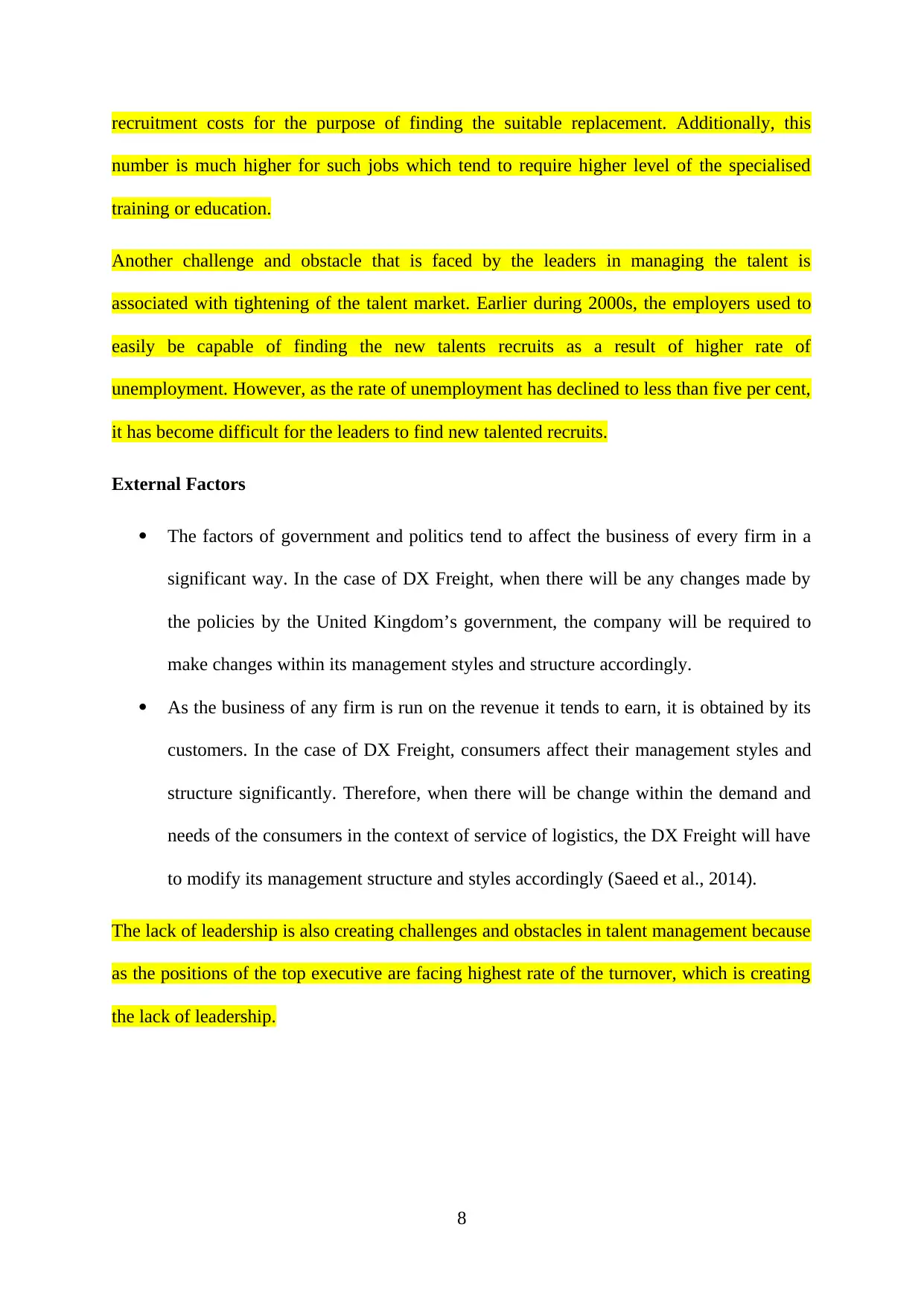
recruitment costs for the purpose of finding the suitable replacement. Additionally, this
number is much higher for such jobs which tend to require higher level of the specialised
training or education.
Another challenge and obstacle that is faced by the leaders in managing the talent is
associated with tightening of the talent market. Earlier during 2000s, the employers used to
easily be capable of finding the new talents recruits as a result of higher rate of
unemployment. However, as the rate of unemployment has declined to less than five per cent,
it has become difficult for the leaders to find new talented recruits.
External Factors
The factors of government and politics tend to affect the business of every firm in a
significant way. In the case of DX Freight, when there will be any changes made by
the policies by the United Kingdom’s government, the company will be required to
make changes within its management styles and structure accordingly.
As the business of any firm is run on the revenue it tends to earn, it is obtained by its
customers. In the case of DX Freight, consumers affect their management styles and
structure significantly. Therefore, when there will be change within the demand and
needs of the consumers in the context of service of logistics, the DX Freight will have
to modify its management structure and styles accordingly (Saeed et al., 2014).
The lack of leadership is also creating challenges and obstacles in talent management because
as the positions of the top executive are facing highest rate of the turnover, which is creating
the lack of leadership.
8
number is much higher for such jobs which tend to require higher level of the specialised
training or education.
Another challenge and obstacle that is faced by the leaders in managing the talent is
associated with tightening of the talent market. Earlier during 2000s, the employers used to
easily be capable of finding the new talents recruits as a result of higher rate of
unemployment. However, as the rate of unemployment has declined to less than five per cent,
it has become difficult for the leaders to find new talented recruits.
External Factors
The factors of government and politics tend to affect the business of every firm in a
significant way. In the case of DX Freight, when there will be any changes made by
the policies by the United Kingdom’s government, the company will be required to
make changes within its management styles and structure accordingly.
As the business of any firm is run on the revenue it tends to earn, it is obtained by its
customers. In the case of DX Freight, consumers affect their management styles and
structure significantly. Therefore, when there will be change within the demand and
needs of the consumers in the context of service of logistics, the DX Freight will have
to modify its management structure and styles accordingly (Saeed et al., 2014).
The lack of leadership is also creating challenges and obstacles in talent management because
as the positions of the top executive are facing highest rate of the turnover, which is creating
the lack of leadership.
8
⊘ This is a preview!⊘
Do you want full access?
Subscribe today to unlock all pages.

Trusted by 1+ million students worldwide
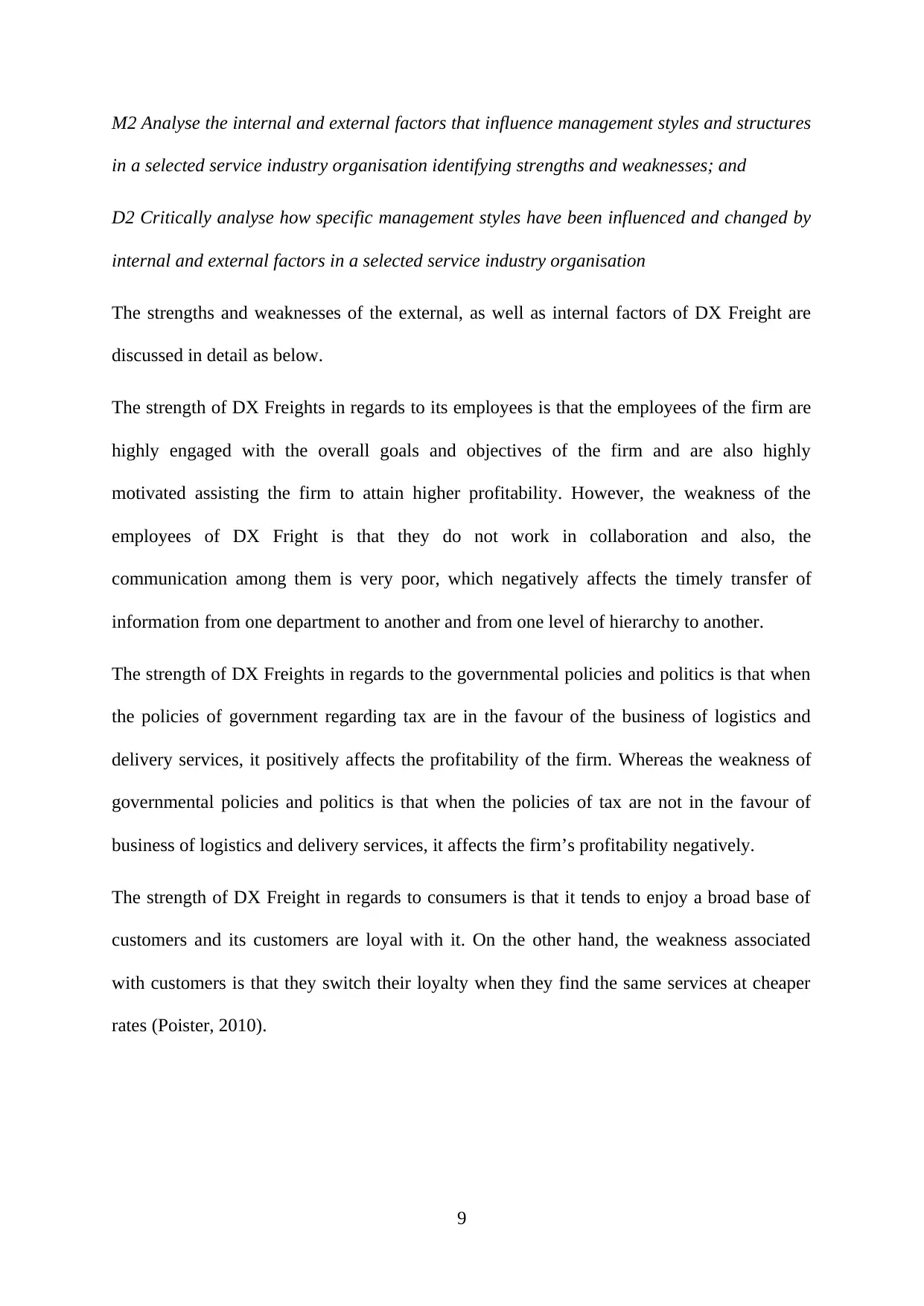
M2 Analyse the internal and external factors that influence management styles and structures
in a selected service industry organisation identifying strengths and weaknesses; and
D2 Critically analyse how specific management styles have been influenced and changed by
internal and external factors in a selected service industry organisation
The strengths and weaknesses of the external, as well as internal factors of DX Freight are
discussed in detail as below.
The strength of DX Freights in regards to its employees is that the employees of the firm are
highly engaged with the overall goals and objectives of the firm and are also highly
motivated assisting the firm to attain higher profitability. However, the weakness of the
employees of DX Fright is that they do not work in collaboration and also, the
communication among them is very poor, which negatively affects the timely transfer of
information from one department to another and from one level of hierarchy to another.
The strength of DX Freights in regards to the governmental policies and politics is that when
the policies of government regarding tax are in the favour of the business of logistics and
delivery services, it positively affects the profitability of the firm. Whereas the weakness of
governmental policies and politics is that when the policies of tax are not in the favour of
business of logistics and delivery services, it affects the firm’s profitability negatively.
The strength of DX Freight in regards to consumers is that it tends to enjoy a broad base of
customers and its customers are loyal with it. On the other hand, the weakness associated
with customers is that they switch their loyalty when they find the same services at cheaper
rates (Poister, 2010).
9
in a selected service industry organisation identifying strengths and weaknesses; and
D2 Critically analyse how specific management styles have been influenced and changed by
internal and external factors in a selected service industry organisation
The strengths and weaknesses of the external, as well as internal factors of DX Freight are
discussed in detail as below.
The strength of DX Freights in regards to its employees is that the employees of the firm are
highly engaged with the overall goals and objectives of the firm and are also highly
motivated assisting the firm to attain higher profitability. However, the weakness of the
employees of DX Fright is that they do not work in collaboration and also, the
communication among them is very poor, which negatively affects the timely transfer of
information from one department to another and from one level of hierarchy to another.
The strength of DX Freights in regards to the governmental policies and politics is that when
the policies of government regarding tax are in the favour of the business of logistics and
delivery services, it positively affects the profitability of the firm. Whereas the weakness of
governmental policies and politics is that when the policies of tax are not in the favour of
business of logistics and delivery services, it affects the firm’s profitability negatively.
The strength of DX Freight in regards to consumers is that it tends to enjoy a broad base of
customers and its customers are loyal with it. On the other hand, the weakness associated
with customers is that they switch their loyalty when they find the same services at cheaper
rates (Poister, 2010).
9
Paraphrase This Document
Need a fresh take? Get an instant paraphrase of this document with our AI Paraphraser
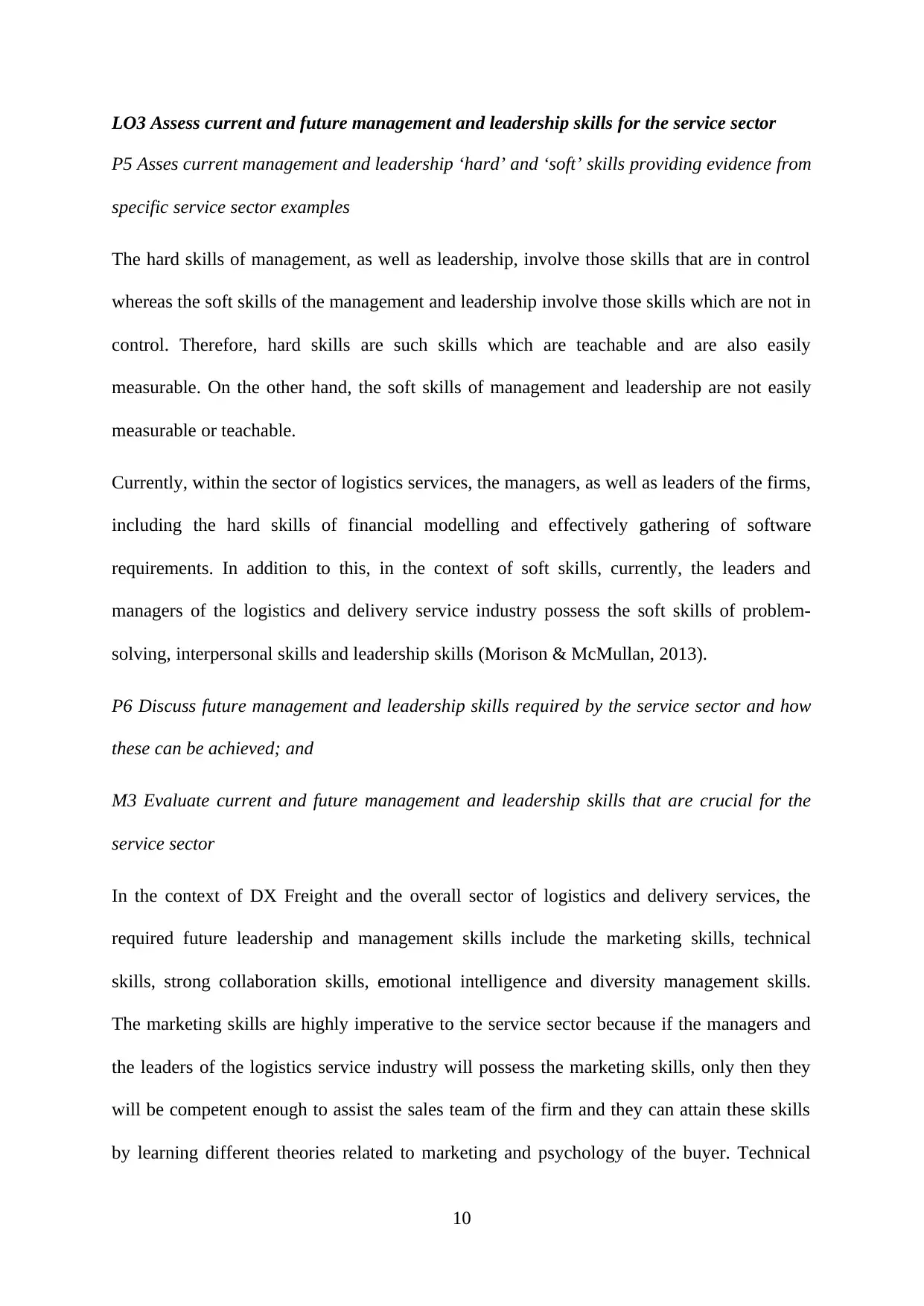
LO3 Assess current and future management and leadership skills for the service sector
P5 Asses current management and leadership ‘hard’ and ‘soft’ skills providing evidence from
specific service sector examples
The hard skills of management, as well as leadership, involve those skills that are in control
whereas the soft skills of the management and leadership involve those skills which are not in
control. Therefore, hard skills are such skills which are teachable and are also easily
measurable. On the other hand, the soft skills of management and leadership are not easily
measurable or teachable.
Currently, within the sector of logistics services, the managers, as well as leaders of the firms,
including the hard skills of financial modelling and effectively gathering of software
requirements. In addition to this, in the context of soft skills, currently, the leaders and
managers of the logistics and delivery service industry possess the soft skills of problem-
solving, interpersonal skills and leadership skills (Morison & McMullan, 2013).
P6 Discuss future management and leadership skills required by the service sector and how
these can be achieved; and
M3 Evaluate current and future management and leadership skills that are crucial for the
service sector
In the context of DX Freight and the overall sector of logistics and delivery services, the
required future leadership and management skills include the marketing skills, technical
skills, strong collaboration skills, emotional intelligence and diversity management skills.
The marketing skills are highly imperative to the service sector because if the managers and
the leaders of the logistics service industry will possess the marketing skills, only then they
will be competent enough to assist the sales team of the firm and they can attain these skills
by learning different theories related to marketing and psychology of the buyer. Technical
10
P5 Asses current management and leadership ‘hard’ and ‘soft’ skills providing evidence from
specific service sector examples
The hard skills of management, as well as leadership, involve those skills that are in control
whereas the soft skills of the management and leadership involve those skills which are not in
control. Therefore, hard skills are such skills which are teachable and are also easily
measurable. On the other hand, the soft skills of management and leadership are not easily
measurable or teachable.
Currently, within the sector of logistics services, the managers, as well as leaders of the firms,
including the hard skills of financial modelling and effectively gathering of software
requirements. In addition to this, in the context of soft skills, currently, the leaders and
managers of the logistics and delivery service industry possess the soft skills of problem-
solving, interpersonal skills and leadership skills (Morison & McMullan, 2013).
P6 Discuss future management and leadership skills required by the service sector and how
these can be achieved; and
M3 Evaluate current and future management and leadership skills that are crucial for the
service sector
In the context of DX Freight and the overall sector of logistics and delivery services, the
required future leadership and management skills include the marketing skills, technical
skills, strong collaboration skills, emotional intelligence and diversity management skills.
The marketing skills are highly imperative to the service sector because if the managers and
the leaders of the logistics service industry will possess the marketing skills, only then they
will be competent enough to assist the sales team of the firm and they can attain these skills
by learning different theories related to marketing and psychology of the buyer. Technical
10
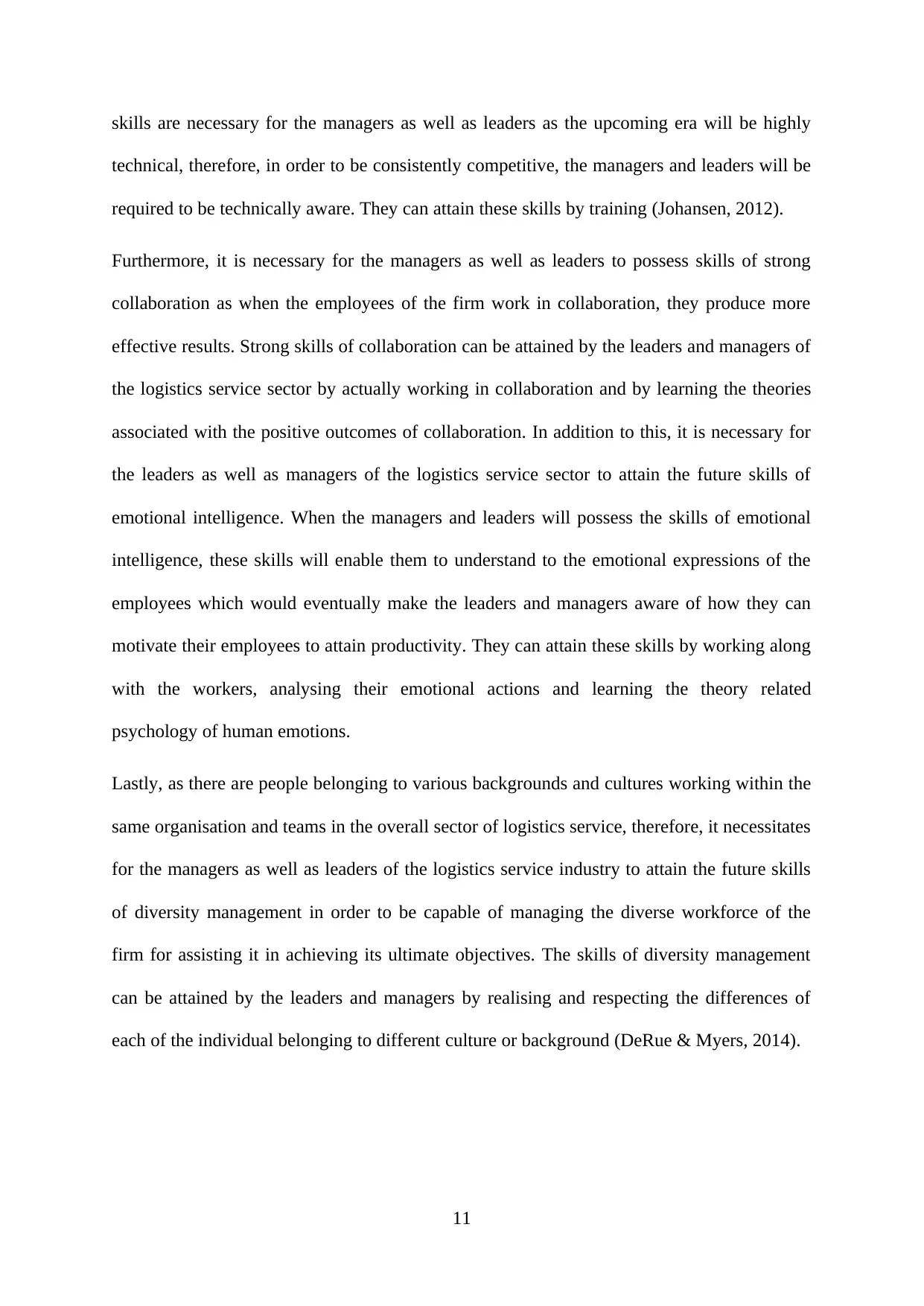
skills are necessary for the managers as well as leaders as the upcoming era will be highly
technical, therefore, in order to be consistently competitive, the managers and leaders will be
required to be technically aware. They can attain these skills by training (Johansen, 2012).
Furthermore, it is necessary for the managers as well as leaders to possess skills of strong
collaboration as when the employees of the firm work in collaboration, they produce more
effective results. Strong skills of collaboration can be attained by the leaders and managers of
the logistics service sector by actually working in collaboration and by learning the theories
associated with the positive outcomes of collaboration. In addition to this, it is necessary for
the leaders as well as managers of the logistics service sector to attain the future skills of
emotional intelligence. When the managers and leaders will possess the skills of emotional
intelligence, these skills will enable them to understand to the emotional expressions of the
employees which would eventually make the leaders and managers aware of how they can
motivate their employees to attain productivity. They can attain these skills by working along
with the workers, analysing their emotional actions and learning the theory related
psychology of human emotions.
Lastly, as there are people belonging to various backgrounds and cultures working within the
same organisation and teams in the overall sector of logistics service, therefore, it necessitates
for the managers as well as leaders of the logistics service industry to attain the future skills
of diversity management in order to be capable of managing the diverse workforce of the
firm for assisting it in achieving its ultimate objectives. The skills of diversity management
can be attained by the leaders and managers by realising and respecting the differences of
each of the individual belonging to different culture or background (DeRue & Myers, 2014).
11
technical, therefore, in order to be consistently competitive, the managers and leaders will be
required to be technically aware. They can attain these skills by training (Johansen, 2012).
Furthermore, it is necessary for the managers as well as leaders to possess skills of strong
collaboration as when the employees of the firm work in collaboration, they produce more
effective results. Strong skills of collaboration can be attained by the leaders and managers of
the logistics service sector by actually working in collaboration and by learning the theories
associated with the positive outcomes of collaboration. In addition to this, it is necessary for
the leaders as well as managers of the logistics service sector to attain the future skills of
emotional intelligence. When the managers and leaders will possess the skills of emotional
intelligence, these skills will enable them to understand to the emotional expressions of the
employees which would eventually make the leaders and managers aware of how they can
motivate their employees to attain productivity. They can attain these skills by working along
with the workers, analysing their emotional actions and learning the theory related
psychology of human emotions.
Lastly, as there are people belonging to various backgrounds and cultures working within the
same organisation and teams in the overall sector of logistics service, therefore, it necessitates
for the managers as well as leaders of the logistics service industry to attain the future skills
of diversity management in order to be capable of managing the diverse workforce of the
firm for assisting it in achieving its ultimate objectives. The skills of diversity management
can be attained by the leaders and managers by realising and respecting the differences of
each of the individual belonging to different culture or background (DeRue & Myers, 2014).
11
⊘ This is a preview!⊘
Do you want full access?
Subscribe today to unlock all pages.

Trusted by 1+ million students worldwide
1 out of 17
Related Documents
Your All-in-One AI-Powered Toolkit for Academic Success.
+13062052269
info@desklib.com
Available 24*7 on WhatsApp / Email
![[object Object]](/_next/static/media/star-bottom.7253800d.svg)
Unlock your academic potential
Copyright © 2020–2025 A2Z Services. All Rights Reserved. Developed and managed by ZUCOL.
